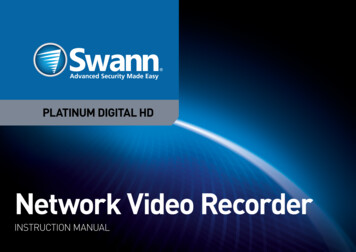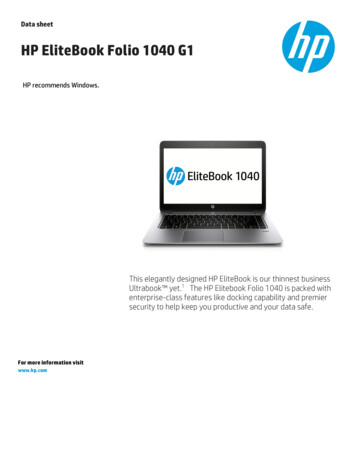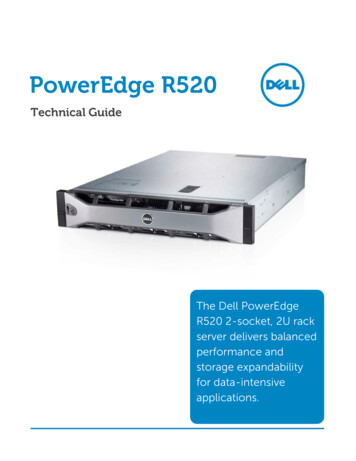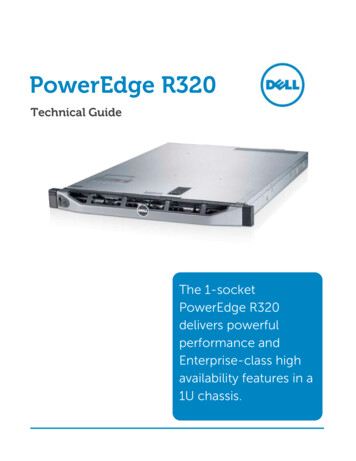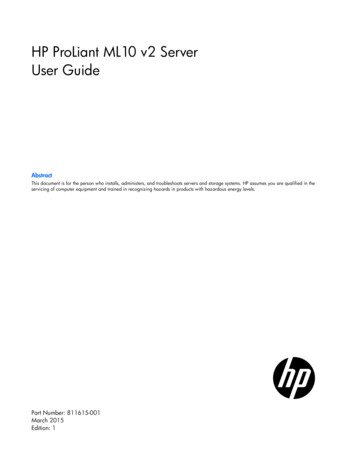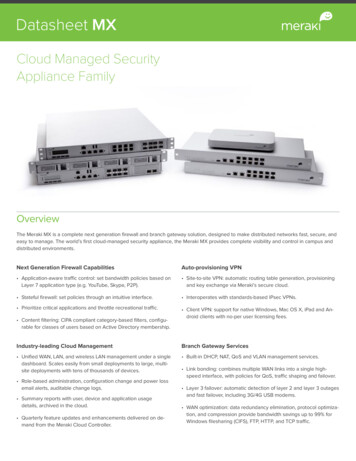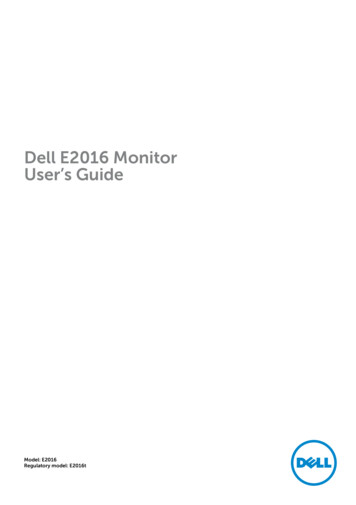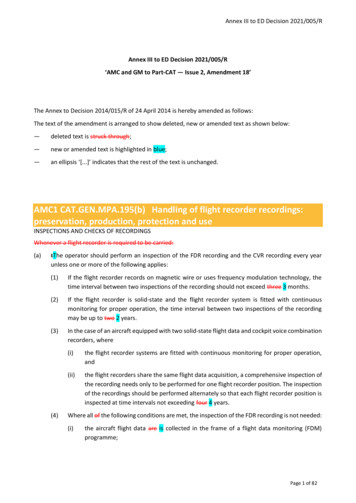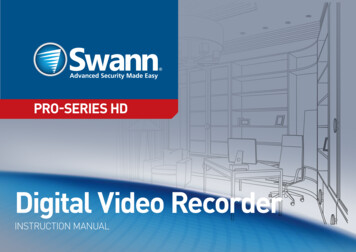
Transcription
PRO-SERIES HDDigital Video RecorderINSTRUCTION MANUAL1
Important InformationFCC VerificationThis equipment has been tested and found to comply with the limits forClass B digital device, pursuant to part 15 of the FCC Rules. These limitsare designed to provide reasonable protection against harmful interference in a residential installation. This equipment generates, uses andcan radiate radio frequency energy and, if not installed and used in accordance with the instructions, may cause harmful interference to radioor television reception, which can be determined by turning the equipment off and on, the user is encouraged to try to correct the interferenceby one or more of the following measures: Reorient or relocate the receiving antenna Increase the separation between the equipment and the receiver Connect the equipment into an outlet on a circuit different from thatto which the receiver is connected Consult the dealer or an experienced radio/TV technician for helpThese devices comply with part 15 of the FCC Rules. Operation is subject to the following two conditions: These devices may not cause harmful interference These devices must accept any interference received, including interference that may cause undesired operationImportant Notice - All jurisdictions have specific laws and regulationsrelating to the use of cameras. Before using any camera for any purpose, it is the buyer’s responsibility to be aware of all applicable lawsand regulations that prohibit or limit the use of cameras and to complywith the applicable laws and regulations.FCC Regulation (for USA): Prohibition against eavesdroppingExcept for the operations of law enforcement officers conducted underlawful authority, no person shall use, either directly or indirectly, a device operated pursuant to the provisions of this Part for the purposeof overhearing or recording the private conversations of others unlesssuch use is authorized by all of the parties engaging in the conversation.Warning - Changes or modifications made to this device not approvedexpressly by the party responsible for compliance could void the user’sauthority to operate the equipment.Important Safety Instructions Make sure product is fixed correctly and stable if fastened in place Do not operate if wires and terminals are exposed Do not cover vents on the side of the device and allow adequate spacefor ventilation Only use the power adapter supplied with the DVRPassword InformationThis DVR does not have a default password. A password is created during the Setup Wizard. If password protection has been enabled and youhave forgotten your password, you can enter a super password. Click“Forgot Password” then input the DVR’s MAC address without the colons, for example, EC71DBE32877.The DVR’s Mac address can be obtained using SwannView Link for Windows. Please download it from our website.About this ManualThis instruction manual is written for the DVR-4600 and was accurate atthe time it was completed. However, because of our on-going efforts toconstantly improve our products, additional features and functions mayhave been added since that time. We encourage you to visit our websiteto check for the latest updates and product announcements.2
ContentsImportant Information 2Recording: Option 24Contents 3Recording: Schedule 25Live View 5Chapter 4 - Playback & Backup 26Chapter 1 - Menu 6Search: Playback 27Menu Layout 7The Playback Interface 28Chapter 2 - Camera Configuration8Search: Event 30Display: Camera 9Search: Backup 31Creating a Privacy Mask 10Chapter 5 - System Configuration 32Recording: Encode 11System: General 33Alarm: Motion 12System: User 34Motion Detection 13System Maintenance 35Motion Detection Schedule 14Alarm: Exception 36Motion Detection Tips 15Device: HDD 37Alarm: Video Loss 16Display: Output 38Video Loss Schedule 17Network: General 39Device: PTZ 18Network: Advanced 40Controlling a PTZ Camera 19Chapter 6 - System Status 41Creating a Preset 20Search: Log Search 42Creating a Patrol 21Network: Status 43Chapter 3 - Recording Configuration 22Device: S.M.A.R.T 44Recording: Encode 23System: System Information 453
Contents (cont.)Warranty Information 46Helpdesk & Technical Support 474
Live ViewLive View is the default display mode for the DVR. Each camera connected will be displayed on-screen. You can check the status or operation of yourDVR and cameras using the icons and Menu Bar on the Live View screen. Right-click the mouse to access the Menu Bar.Double-click alive video channel to view fullscreen.29/09/2015 10:30:15 TueStatus IconsCamera1Camera2Camera ToolbarClick & drag alive video channel to repositionit.Menu Bar11. Opens the Menu.2. Click to view a single camera.3. Click to view four cameras.4. Click to view eight cameras.234567895. Click to view nine cameras.8. Click to manually record the6. Click to view the next screen in selected camera.single or four camera view.9. Click to access the Setup Wizard.7. Click to enable PIP mode.5
MenuThe Menu is where you controlthe various actions and optionsthat are available on the DVR.You can also access previously recorded video for playbackand to export to a USB storagedevice such as a flash drive.To maintain system integrity, afirmware upgrade can be performed when available and access to the shutdown menu torestart or safely turn off theDVR.6
Menu LayoutClicking each category will reveal anumber of tabs or sub-categoriesthat can be changed from their default value.The various actions and optionsthat are available, are categorisedon the left-hand side of the Menu.To exit or access theprevious menu, rightclick the mouse.To shutdown, reboot or lockthe DVR, click the “Shutdown”button. To ensure the integrity of your data and recordings,always select “Shutdown”when powering off the DVR.Some options may have additionalmenus that can be accessed.7
Camera ConfigurationThe majority of the camera configuration options available arein the “Display”, “Recording”,“Alarm” and “Device” menusthat are accessible from theMenu. You can change the resolution and bitrate settings aswell as the image settings forbrightness and contrast. TheDVR has several controls forMotion Detection, Video Lossand the ability to create one ormore privacy masks.8
Display: CameraThe configuration options available allowyou to name each camera relevant to where ithas been installed aswell as the ability toadjust image settingssuch as brightnessand contrast.Camera No.: Select a camera that you would like to configure.Brightness: This changes how light the image appears to be.Camera Name: Select a name for the camera you’ve selected. It can beup to 16 characters in length.Contrast: This increases the difference between the blackest black andthe whitest white in the image.Display Camera Name: Leave this enabled if you would like to displaythe camera name on the Live View screen, otherwise click to disable.Saturation: This alters how much colour is displayed in the image. Thehigher the saturation, the more bright and vivid colours will appear.Record Date: It’s recommended to leave this enabled as it creates aninseparable record of exactly when the footage was captured.Hue: This changes the colour mix of the image.OSD Display Position: Click the “Set” button to change the position ofthe camera name on the Live View screen. Use the mouse to repositionthe camera name. Right-click the mouse then click “Save” to exit.Image Settings: This gives you access to the image adjustment tools.Click the “Set” button to change then click “OK” when finished.Mask: Click the checkbox to enable then click “Area Settings” to createone or more privacy masks - see page 10 for more information. Click the “Default” button to revert back to default settings. Use the “Copy to” button to apply all settings to the other cameras. Don’t forget to click “Apply” to save settings. Right-click the mouse to exit the Menu.9
Creating a Privacy MaskA privacy mask can beused if you want to obscure part of your image for privacy. You canalso use this option tominimize false triggers for Motion Detection. You can create upto four areas per camera to mask. Any areaobscured by a privacymask won’t be shownlive or recorded.1. Using the mouse, click & drag to select the area that you want tocreate a privacy mask for (as shown above). Up to four masks can becreated.2. To delete a mask, move the mouse pointer within the mask, rightclick the mouse to access the sub-menu (as shown above) then click“Delete Area”. Click “Delete All” to delete all masks. Click “Save” tosave your mask or click “Cancel” to exit. Click the “Default” button to revert back to default settings. Use the “Copy to” button to apply all settings to the other cameras. Don’t forget to click “Apply” to save settings. Right-click the mouse to exit the Menu.10
Recording: EncodeThe Encode functionallows you to changethe resolution and bitrate for each cameraconnected. The maximum Main Streamresolution is 1080P(1920 x 1080) at 20fps,which fits in with thecapabilities of the provided cameras. TheSub stream resolutionis Q720p (320 x 180).Camera No.: Select a camera that you would like to configure.Encoding Parameters: Select which parameter that you would like toconfigure, Main Stream or Sub stream.Record Audio: See page 23 for more information.Resolution: The resolution is 1080P for Main Stream and Q720p for Substream. By default, the SwannView Link app and Windows software utilises the Sub stream parameter to display an image from the DVR toyour mobile device or computer.and 128Kbps for Sub stream. Change the Sub stream bitrate if you’rehaving issues streaming to your mobile device or computer. By loweringthe quality, you reduce the amount of data that is required. Click the “Default” button to revert back to default settings. Use the “Copy to” button to apply all settings to the other cameras. Don’t forget to click “Apply” to save settings. Right-click the mouse to exit the Menu.Frame Rate(fps): The default frame rate is 20fps for Main Stream and4fps for Sub stream. Change the Sub stream frame rate if you’re havingissues streaming to your mobile device or computer.Max. BitRate(Kbps): The default bitrate is 4096Kbps for Main Stream11
Alarm: MotionWhether you’re waitingfor an expected event,hoping you don’t spotan unwelcome visitor,or just curious aboutwhat happens whenyou’re not around, Motion Detection can beconfigured to alert youand record video onlywhen it detects motion. Motion Detectionis enabled by default.Channel: Select a camera that you would like to configure.Enable: Motion Detection is enabled by default.Motion Detection: Click the “Set” button to change the default MotionDetection area - see page 13 for more information.Schedule: Click the “Set” button to change the default Motion Detectionalarm schedule - see page 14 for more information.Action: Click the “Set” button to enable an audio warning, to send anemail and to trigger other cameras when motion is detected. Click the “Default” button to revert back to default settings. Use the “Copy to” button to apply all settings to the other cameras. Don’t forget to click “Apply” to save settings. Right-click the mouse to exit the Menu.12
Motion DetectionUsing the “Sensitivity” function, you canchange the motion sensitivity level for eachtime period available. The level is controlledby a slider, allowing you to set a value between 0 and 50. The lower the number, themore sensitive the Motion Detection will be.Motion Detection is an essential part of your security system. It’s themain method that detects when someone is in your home when theyshouldn’t be. When motion has been detected by one or more cameras,a signal is sent to your DVR, alerting you to a potential threat in yourhome. It does this in several ways such as activating an audio warningusing its internal buzzer, sending an email and sending an alert to yoursmartphone or tablet. You can also configure your DVR so it triggers theother cameras to start recording.1. Right-click the mouse to access the sub-menu then click “Delete All”.2. Click & drag to select the area that you want to create a zone for. Multiple zones can be created. The same action also applies if you want todelete a zone that has been created.Motion Detection is the default recording mode for the DVR. The entireview of the camera is enabled to detect motion, however you can selectcertain areas if you wish. In the above example, a Motion Detection zonehas been set up for the windows and dining room entrance. Movementoutside of these zones will not be detected. Click the “Default” button to revert back to default settings.3. You can adjust the sensitivity level (see above) if required.4. Right-click the mouse to access the sub-menu then click “Save” tosave any changes that you have made. To revert back to default settingsclick “Add to All” or click “Cancel” to exit. Use the “Copy to” button to apply all settings to the other cameras. Don’t forget to click “Apply” to save settings. Right-click the mouse to exit the Menu.13
Motion Detection ScheduleBy default, a Motion Detection alarm schedulehas been enabled foreach connected camera. You can howeverchange the scheduleaccording to what fitsin with your needs. Theschedule is presentedas a 24 hour 7 days aweek grid and is colourcoded to represent theevent type.In the above example, a schedule has been created for 06:00 a.m. to06:00 p.m. Sunday to Saturday. Using the mouse, click on a particularsquare or click & drag to change a section. Click the “Default” button to revert back to default settings. Don’t forget to click “Apply” to save settings. Click “Cancel” to exit. Right-click the mouse to exit the Menu.14
Motion Detection TipsPlacement of the camerasBedroomBackdoor1. Keep cameras 10 - 15 feet (3 - 4 metres) away from heating vents, where the sunlight shines in, andradiators. If a camera detects a swift change in motion, even that of a cloud passing quickly over directsunlight shining into your living room, Motion Detection could be activated.2. Place cameras in areas where people have to walk through, like the stairwell, main hallway or entrydoor. That way, an intruder will activate Motion Detection regardless of where they are headed. Intrudersusually go right for the master bedroom, so put a camera near that room or other rooms where you havevaluables, like the study.3. Walk through your house and assess where intruders are most likely to enter, and what path they wouldtake. Most burglars enter the home through a front or back door, so it’s advisable to place the camerasnear those areas.Hallways4. When installing cameras outside, it’s important to keep your front and backyard well-lit for ideal nightvision and the ability to detect motion. It’s common for intruders to enter a home through an unlockedgarage or by using a garage door opener in an unlocked car located in the driveway.Avoiding false triggers1. A flag or foliage that is blown by the wind - Angle the camera so wind-blown objects are out of thecamera’s view.Frontdoor2. Pets moving in front of the camera - Lower the sensitivity level and/or point the camera into areas thatare not particular high-traffic for your pets.3. Vehicles moving in the background - Angle the camera so as to avoid movement in the background.4. Moving air from a heater or air conditioner - Angle the camera away from heater and air conditionersources.5. Movement reflected off smooth surfaces such as glass - Lower the sensitivity level and/or avoid pointingthe camera directly at glass surfaces.15
Alarm: Video LossVideo Loss is regardedas a potential alarmevent and is considered to occur any timethe DVR doesn’t receive an active videosignal from any of itsvideo inputs. When avideo input has no incoming signal, a “VIDEO LOSS” messagewill appear on-screen.Channel: Select a camera that you would like to configure.Enable: Click the checkbox to enable.Schedule: Click the “Set” button to change the default Video Loss alarmschedule - see page 17 for more information.Action: Click the “Set” button to enable an audio warning and to sendan email. Click the “Default” button to revert back to default settings. Use the “Copy to” button to apply all settings to the other cameras. Don’t forget to click “Apply” to save settings. Right-click the mouse to exit the Menu.16
Video Loss ScheduleIn the above example, a schedule has been created for 06:00 a.m. to06:00 p.m. Sunday to Saturday. Using the mouse, click on a particularsquare or click & drag to change a section. Click the “Default” button to revert back to default settings. Don’t forget to click “Apply” to save settings. Click “Cancel” to exit. Right-click the mouse to exit the Menu.17
Device: PTZIf you have a PTZ camera connected to theDVR, use this menu toconfigure settings foryour device. Pleaseconsult the user manual included with yourcamera for specificconfiguration instructions.Camera No.: Select a camera that you would like to configure. Click the “Default” button to revert back to default settings.Baudrate: Most devices operate at 2400 or 9600. Use the “Copy to” button to apply all settings to the other cameras.Data Bit: Most devices operate at 8. Don’t forget to click “Apply” to save settings.Stop Bit: Most devices operate at 1. Right-click the mouse to exit the Menu.Parity: Most devices have the parity set to “None”.Flow Ctrl: Most devices have the parity set to “None”.PTZ Protocol: “PELCO-D” and “PELCO-P” are popular camera controlprotocols used in the CCTV industry. This ensures that any PTZ camerayou have purchased, will work with this DVR. For the best result, werecommend using a Swann branded PTZ camera.Please note - Don’t use Motion Detection on channels with a PTZcamera connected. As a PTZ camera can pan, tilt & zoom, theDVR will detect this as motion instead of a moving object.Address(0-255): The command address of the device you want to associate with this channel.18
Controlling a PTZ Camera7891011121314145623To control a PTZ camera, use the mouse and click the channel the camera is connected to. Click the “PTZ” button on the camera toolbar. ThePTZ controls will appear on-screen.7. Click this to select a different channel.1. Click the directional buttons to move the camera in the direction selected.10 (4). Click this to access the Preset menu - see page 20 for more information.2. This determines how fast the camera will move. The lower the number the slower the camera will move (this does not affect the speedwhen the camera is in Patrol mode).3. The ability to zoom into an object and to control the level of focus (the“Iris” controls are not available).To access the PTZ menu, right-click the mouse (as seen above).8. Click this to select a different Preset position.9. Click this to select a different Patrol mode.11 (5). Click this to access the Patrol menu - see page 21 for more information.12. Click this to hide the PTZ controls. Click again to return.13. Click this to access the PTZ settings menu.14 (6). Click this to exit. You will be taken back to the default Live Viewmode.19
Creating a Preset312451. Use the PTZ controls to move the camera to the desired focal position.The Zoom and Focus controls can also be used.Call: Select a saved Preset slot then click this to move the camera to thePreset position.2. Click the “Preset” button to access the Preset menu.Clear All: Click this to clear all Preset slots.3. Click the first Preset slot available then click “pos1” to change thename to something more relevant (you can leave the default name if youwish).Clear: Select a saved Preset slot then click this to clear.4. Click the “Set” button t
5 Live View Live View is the default display mode for the DVR. Each camera connected will be displayed
